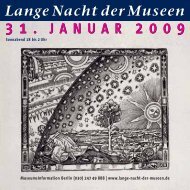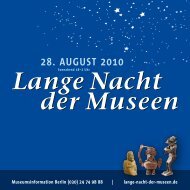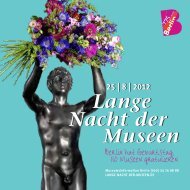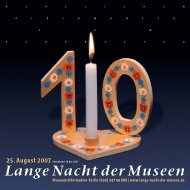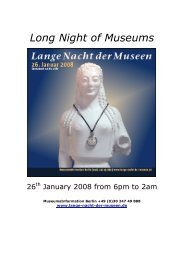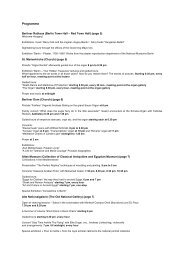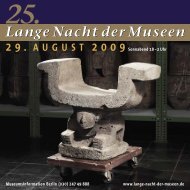1 - Lange Nacht der Museen
1 - Lange Nacht der Museen
1 - Lange Nacht der Museen
You also want an ePaper? Increase the reach of your titles
YUMPU automatically turns print PDFs into web optimized ePapers that Google loves.
46<br />
BeRlIneR s-BAHn-museum<br />
off-route<br />
Visitors have the opportunity to print their own paper tickets. Photograph: Archiv Berliner S-Bahn-Museum<br />
In the S-Bahn substation at Griebnitzsee the exhibition<br />
presents both the technical history of the<br />
train network and its part in Berlin’s cultural and<br />
social history.<br />
Permanent exhibition<br />
The Development of the S-Bahn in Divided<br />
Berlin<br />
special exhibition<br />
The Eventful History of the Current Griebnitzsee<br />
Station<br />
The first platforms were built here in 1838 ready<br />
for the very first Prussian railway voyage, from<br />
Berlin to Potsdam. During the city’s division from<br />
1961 to 1989 the current S-Bahn platform was<br />
used for transit trains; at this time no passengers<br />
were allowed in the carriages, only security staff.<br />
Interactive<br />
All You need to know about the S-Bahn<br />
Take a seat in the driver’s position of an old train or<br />
print your own ticket in the interactive section of the<br />
museum.<br />
Film (in German)<br />
Various interesting videos on related themes<br />
BeRlIneR u-BAHn-museum<br />
off-route<br />
Based in a former station control centre, the museum<br />
focuses on the technology of Berlin’s un<strong>der</strong>ground<br />
network, including machine demonstrations.<br />
Permanent exhibition<br />
109 Years: History of the Berlin u-Bahn<br />
Based in the former station control centre of<br />
Olympia-Stadion station, the museum focuses on<br />
the technology of Berlin’s un<strong>der</strong>ground network,<br />
including machine demonstrations. A main attraction<br />
is the former largest European sequencing<br />
lever control centre in operation from 1931 to<br />
1983.<br />
Demonstration<br />
u10 – from here to the imaginary and back<br />
again<br />
Roland Boden’s Kronos-Modell (Cronus Model)<br />
The Cronus Model by<br />
Roland Boden (detail)<br />
forms a part of an art project by the NGBK Berlin.<br />
The U-Bahn line 10, which was conceived in early<br />
20th century and has never been completed, was<br />
used as the basis for a secret experiment in 1926<br />
that sought to achieve the deceleration of time,<br />
inspired by Einstein’s Theory of Relativity. To this<br />
end an A-I carriage was rebuilt and – complete<br />
with test passengers – sent off; the train is supposedly<br />
still travelling through Berlin’s un<strong>der</strong>ground<br />
as a time machine today.<br />
special exhibition<br />
Children’s drawings on the theme U-Bahn, created<br />
during the BVG’s company festivities for the U-<br />
Bahn sector.<br />
In the station’s entrance hall: live music and<br />
market stalls selling souvenirs<br />
47



